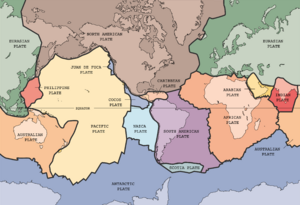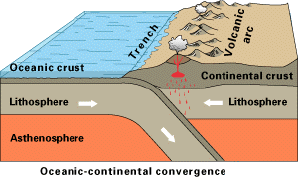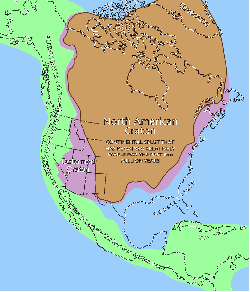Difference between revisions of "Lithosphere" - New World Encyclopedia
(edited caption) |
Rosie Tanabe (talk | contribs) |
||
| (25 intermediate revisions by 6 users not shown) | |||
| Line 1: | Line 1: | ||
| + | {{Copyedited}}{{Paid}}{{Submitted}}{{Images OK}}{{Approved}} | ||
| + | [[Category:Public]] | ||
[[Image:Tectonic plates.png|thumb|right|300px|The tectonic plates of the Earth's lithosphere.]] | [[Image:Tectonic plates.png|thumb|right|300px|The tectonic plates of the Earth's lithosphere.]] | ||
| − | The '''lithosphere''' (from the [[Greek language|Greek]] for "rocky" sphere) is the solid, outermost shell of a rocky [[planet]]. In the case of the [[Earth]], the lithosphere includes the [[Crust (geology)|crust]] and the upper layer of the [[Mantle (geology)|mantle]] that is joined to the crust. | + | The '''lithosphere''' (from the [[Greek language|Greek]] for "rocky" sphere) is the solid, outermost shell of a rocky [[planet]]. In the case of the [[Earth]], the lithosphere includes the [[Crust (geology)|crust]] and the upper layer of the [[Mantle (geology)|mantle]] that is joined to the crust. The lithosphere contains a rich variety of minerals. In addition, it continually interacts with the [[Earth's atmosphere|atmosphere]] and [[hydrosphere]]. |
| + | {{toc}} | ||
| + | The Earth's lithosphere provides us with the "terra firma" on which we live. To sustain our lives, we need access to air, water, soil, and sunlight, and we need the ecosystems created by plants and animals. The lithosphere gives us access to all of these simultaneously. While dwelling on the lithosphere, we are surrounded by air, receive the Sun's heat and light, and have access to freshwater and various minerals that we use for our domestic, agricultural, and industrial activities. | ||
== Plate tectonics == | == Plate tectonics == | ||
| + | :{{main|Plate tectonics}} | ||
| − | + | In forming the lithosphere, the Earth's crust and upper mantle are attached to each other, but they differ in chemical composition. The boundary that marks this change in chemical composition is known as the '''Mohorovičić discontinuity''' (or the Moho discontinuity). | |
| − | + | Thus the distinguishing characteristic of the lithosphere is not its composition but its flow properties. It floats on the [[asthenosphere]], which is the heat-softened layer of the mantle below the lithosphere. The lithosphere is fragmented into relatively strong pieces called ''tectonic plates'', which move independently relative to one another. This movement of lithospheric plates over the asthenosphere is described as '''[[plate tectonics]]'''. | |
| − | + | <br clear="all"> | |
| − | + | {|align="center" | |
| − | + | |[[Image:Oceanic-continental convergence Fig21oceancont.gif|thumb|Oceanic / Continental]] | |
| − | + | |[[Image:Continental-continental convergence Fig21contcont.gif|thumb|Continental / Continental]] | |
| + | |[[Image:Oceanic-oceanic convergence Fig21oceanocean.gif|thumb|Oceanic / Oceanic]] | ||
| + | |} | ||
| − | == | + | == Two types of lithosphere == |
| − | |||
| − | ''' | + | There are two types of lithosphere: the '''oceanic lithosphere''', or '''oceanic crust''', and the '''continental lithosphere''', or '''continental crust'''. The oceanic crust is the part of Earth's lithosphere that surfaces in the [[ocean]] basins. The continental crust is the layer of rocks that form the [[continent]]s and areas of shallow seabed close to their shores, known as ''[[Continental shelf|continental shelves]]''. The two types of crust differ in composition, density, and thickness. As a whole, the oceanic crust is thinner but denser than the continental crust. |
| − | + | The oceanic crust is generally less than 10 [[kilometer]]s (km) thick, and its mean density is about 3.3 [[gram]]s per [[cubic centimeter]] (g/cm<sup>3</sup>). The thickness of the continental crust ranges from 20 to 80 km, and its density is less than 3 g/cm<sup>3</sup>. | |
| − | + | [[Image:Earth seafloor crust age 1996.gif|thumb|300px|The oceanic crust. The increase in estimated age of the material is indicated by a progression of colors, from red to yellow to green to blue. Dark red represents newly formed material; dark blue represents crust that is 180 million years old. (Dark gray areas represent landmasses; light gray areas indicate sediment-covered continental shelves.)]] | |
| − | [[Image: | ||
| − | + | As a consequence of the density difference, when active margins of continental crust meet oceanic crust in regions known as ''subduction zones'', the oceanic crust typically sinks beneath the continental crust and is recycled back into the mantle. At the same time, new oceanic crust is continually being produced at mid-ocean ridges from mantle material. In addition, as the oceanic lithosphere grows older, it gets cooler and denser, with the result that if two oceanic plates converge, the older one will subduct below the younger one. As a consequence of these processes, most of the present-day oceanic crust is less than 200 million years old. | |
| − | + | By contrast, the continental crust is rarely subducted or recycled back into the mantle. For this reason, the oldest rocks on Earth are within the stable "cratons" of the continents, rather than in repeatedly recycled oceanic crust. (A craton is a stable part of the continental crust that has survived continental merging and splitting for 500 million years or more.) The oldest continental rock is the [[Acasta Gneiss]], with an estimated age of 4.01 billion (4.01x10<sup>9</sup>) years. | |
| − | + | ===Composition of oceanic crust=== | |
| − | The | + | The oceanic crust is composed mainly of '''mafic''' rocks. The term ''mafic'' is applied to silicate minerals and rocks that have high concentrations of relatively heavy [[Chemical element|element]]s, particularly [[magnesium]] and [[iron]]. The word "mafic" is derived by combining letters from ''[[magnesium]]'' and ''ferrum'', the [[Latin]] word for [[iron]] [http://dictionary.reference.com/search?q=mafic]. |
| − | + | Mafic minerals are usually dark in color. Common rock-forming mafic minerals include [[olivine]], [[pyroxene]], [[amphibole]], [[biotite]] and other [[mica]]s, [[augite]] and calcium-rich [[plagioclase]] [[feldspar|feldspars]]. Common mafic rocks include [[basalt]] and [[gabbro]]. | |
| − | == | + | ===Composition of continental crust=== |
| − | + | [[Image:North america craton nps.gif|right|250px|thumb|The North American craton.]] | |
| − | |||
| − | |||
| − | |||
| − | |||
| − | |||
| − | |||
| − | |||
| − | |||
| − | + | The continental crust consists predominantly of '''felsic''' rocks. The term ''felsic'' is used in referring to silicate minerals, magmas, and rocks that are enriched in [[silica]] and light elements such as [[oxygen]], [[aluminium]], [[sodium]], and [[potassium]]. The word "felsic" combines letters from the words ''[[feldspar]]'' and ''silica''. Felsic minerals are usually light in color. Common felsic minerals include [[quartz]], [[biotite]], [[muscovite]], [[hornblende]], [[orthoclase]], and sodium-rich [[plagioclase]] feldspars. The most common felsic rock is [[granite]]. | |
| − | + | It is a matter of debate whether the amount of continental crust has been increasing, decreasing, or remaining constant over geological time. One model suggests that prior to 3.7 billion years ago, the continental crust constituted less than 10 percent of the present amount. By 3.0 billion years ago, that figure rose to about 25 percent, and by about 2.6 billion years ago, it was about 60 percent of the current amount (Taylor and McLennan 1995). The growth of continental crust is thought to have occurred in "spurts" of activity, corresponding to five episodes of increased production through geologic time (see graphic at [http://earth.leeds.ac.uk/assyntgeology/extra_info/ehistory.htm Butler]). | |
| − | |||
==See also== | ==See also== | ||
| Line 58: | Line 54: | ||
*[[Cryosphere]] | *[[Cryosphere]] | ||
*[[Hydrosphere]] | *[[Hydrosphere]] | ||
| − | |||
*[[Plate tectonics]] | *[[Plate tectonics]] | ||
| + | |||
| + | == References == | ||
| + | |||
| + | *Butler, Rob. ''Making new continents''. http://earth.leeds.ac.uk/assyntgeology/extra_info/ehistory.htm Accessed 01/29/2006 | ||
| + | * [http://www.windows.ucar.edu/cgi-bin/tour_def/earth/interior/earths_crust.html Earth's Crust, Lithosphere and Asthenosphere] | ||
| + | * [http://www.geolsoc.org.uk/template.cfm?name=lithosphere Crust and Lithosphere] | ||
| + | * Stanley Chernicoff and Donna Whitney. ''Geology. An Introduction to Physical Geology'', 4th ed., Pearson 2007 | ||
| + | *Saal, A.L., Rudnick R.L., Ravizza G.E. & Hart S.R. 1998. ''Re-Os [[isotope geochemistry|isotope]] evidence for the composition, formation and age of the lower crust.'' Nature 39317, 1998. | ||
| + | *Taylor and McLennan. 1995. ''Model of growth of continental crust through time'' in John Victor Walther 2005, ''Essentials Of Geochemistry''. ones & Bartlett. ISBN 0763726427 | ||
| + | *von Huene, R. and D.W. Scholl, 1991. "Observations at convergent margins concerning sediment subduction, subduction erosion, and the growth of continental crust." Reviews of Geophysics 29: 279-316. | ||
| + | |||
| + | ==External links== | ||
| + | All links retrieved November 2, 2022. | ||
| + | *[http://www.geo.cornell.edu/geology/classes/geochemdata/CrustalAbundances.html Composition of Continental Crust] | ||
| + | |||
[[Category:Physical sciences]] | [[Category:Physical sciences]] | ||
[[Category:Earth sciences]] | [[Category:Earth sciences]] | ||
[[Category:Geology]] | [[Category:Geology]] | ||
| − | |||
| − | |||
| − | {{ | + | {{credit5|Lithosphere|56979503|Oceanic_crust|57958902|Continental_crust|54702418|Felsic|57590810|Mafic|50956225}} |
Latest revision as of 00:35, 3 November 2022
The lithosphere (from the Greek for "rocky" sphere) is the solid, outermost shell of a rocky planet. In the case of the Earth, the lithosphere includes the crust and the upper layer of the mantle that is joined to the crust. The lithosphere contains a rich variety of minerals. In addition, it continually interacts with the atmosphere and hydrosphere.
The Earth's lithosphere provides us with the "terra firma" on which we live. To sustain our lives, we need access to air, water, soil, and sunlight, and we need the ecosystems created by plants and animals. The lithosphere gives us access to all of these simultaneously. While dwelling on the lithosphere, we are surrounded by air, receive the Sun's heat and light, and have access to freshwater and various minerals that we use for our domestic, agricultural, and industrial activities.
Plate tectonics
In forming the lithosphere, the Earth's crust and upper mantle are attached to each other, but they differ in chemical composition. The boundary that marks this change in chemical composition is known as the Mohorovičić discontinuity (or the Moho discontinuity).
Thus the distinguishing characteristic of the lithosphere is not its composition but its flow properties. It floats on the asthenosphere, which is the heat-softened layer of the mantle below the lithosphere. The lithosphere is fragmented into relatively strong pieces called tectonic plates, which move independently relative to one another. This movement of lithospheric plates over the asthenosphere is described as plate tectonics.
Two types of lithosphere
There are two types of lithosphere: the oceanic lithosphere, or oceanic crust, and the continental lithosphere, or continental crust. The oceanic crust is the part of Earth's lithosphere that surfaces in the ocean basins. The continental crust is the layer of rocks that form the continents and areas of shallow seabed close to their shores, known as continental shelves. The two types of crust differ in composition, density, and thickness. As a whole, the oceanic crust is thinner but denser than the continental crust.
The oceanic crust is generally less than 10 kilometers (km) thick, and its mean density is about 3.3 grams per cubic centimeter (g/cm3). The thickness of the continental crust ranges from 20 to 80 km, and its density is less than 3 g/cm3.
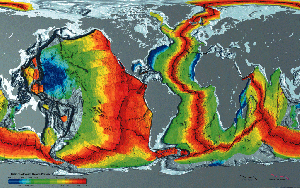
As a consequence of the density difference, when active margins of continental crust meet oceanic crust in regions known as subduction zones, the oceanic crust typically sinks beneath the continental crust and is recycled back into the mantle. At the same time, new oceanic crust is continually being produced at mid-ocean ridges from mantle material. In addition, as the oceanic lithosphere grows older, it gets cooler and denser, with the result that if two oceanic plates converge, the older one will subduct below the younger one. As a consequence of these processes, most of the present-day oceanic crust is less than 200 million years old.
By contrast, the continental crust is rarely subducted or recycled back into the mantle. For this reason, the oldest rocks on Earth are within the stable "cratons" of the continents, rather than in repeatedly recycled oceanic crust. (A craton is a stable part of the continental crust that has survived continental merging and splitting for 500 million years or more.) The oldest continental rock is the Acasta Gneiss, with an estimated age of 4.01 billion (4.01x109) years.
Composition of oceanic crust
The oceanic crust is composed mainly of mafic rocks. The term mafic is applied to silicate minerals and rocks that have high concentrations of relatively heavy elements, particularly magnesium and iron. The word "mafic" is derived by combining letters from magnesium and ferrum, the Latin word for iron [1].
Mafic minerals are usually dark in color. Common rock-forming mafic minerals include olivine, pyroxene, amphibole, biotite and other micas, augite and calcium-rich plagioclase feldspars. Common mafic rocks include basalt and gabbro.
Composition of continental crust
The continental crust consists predominantly of felsic rocks. The term felsic is used in referring to silicate minerals, magmas, and rocks that are enriched in silica and light elements such as oxygen, aluminium, sodium, and potassium. The word "felsic" combines letters from the words feldspar and silica. Felsic minerals are usually light in color. Common felsic minerals include quartz, biotite, muscovite, hornblende, orthoclase, and sodium-rich plagioclase feldspars. The most common felsic rock is granite.
It is a matter of debate whether the amount of continental crust has been increasing, decreasing, or remaining constant over geological time. One model suggests that prior to 3.7 billion years ago, the continental crust constituted less than 10 percent of the present amount. By 3.0 billion years ago, that figure rose to about 25 percent, and by about 2.6 billion years ago, it was about 60 percent of the current amount (Taylor and McLennan 1995). The growth of continental crust is thought to have occurred in "spurts" of activity, corresponding to five episodes of increased production through geologic time (see graphic at Butler).
See also
- Asthenosphere
- Earth
- Earth's atmosphere
- Biosphere
- Cryosphere
- Hydrosphere
- Plate tectonics
ReferencesISBN links support NWE through referral fees
- Butler, Rob. Making new continents. http://earth.leeds.ac.uk/assyntgeology/extra_info/ehistory.htm Accessed 01/29/2006
- Earth's Crust, Lithosphere and Asthenosphere
- Crust and Lithosphere
- Stanley Chernicoff and Donna Whitney. Geology. An Introduction to Physical Geology, 4th ed., Pearson 2007
- Saal, A.L., Rudnick R.L., Ravizza G.E. & Hart S.R. 1998. Re-Os isotope evidence for the composition, formation and age of the lower crust. Nature 39317, 1998.
- Taylor and McLennan. 1995. Model of growth of continental crust through time in John Victor Walther 2005, Essentials Of Geochemistry. ones & Bartlett. ISBN 0763726427
- von Huene, R. and D.W. Scholl, 1991. "Observations at convergent margins concerning sediment subduction, subduction erosion, and the growth of continental crust." Reviews of Geophysics 29: 279-316.
External links
All links retrieved November 2, 2022.
Credits
New World Encyclopedia writers and editors rewrote and completed the Wikipedia article in accordance with New World Encyclopedia standards. This article abides by terms of the Creative Commons CC-by-sa 3.0 License (CC-by-sa), which may be used and disseminated with proper attribution. Credit is due under the terms of this license that can reference both the New World Encyclopedia contributors and the selfless volunteer contributors of the Wikimedia Foundation. To cite this article click here for a list of acceptable citing formats.The history of earlier contributions by wikipedians is accessible to researchers here:
The history of this article since it was imported to New World Encyclopedia:
Note: Some restrictions may apply to use of individual images which are separately licensed.
